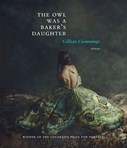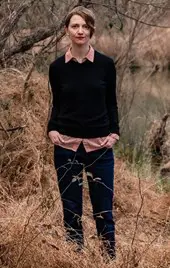Territory of Enchantment: Review of Gillian Cummings’s The Owl was a Baker’s Daughter
by Amie Whittemore

Reviewed: The Owl was a Baker’s Daughter by Gillian Cummings (The Center for Literary Publishing, Colorado State University, 2018), winner of the Colorado Prize for Poetry.
Gillian Cummings’s second full-length collection, The Owl was a Baker’s Daughter, is many things—beautiful and musical, tender and quietly daring—but perhaps its most dominant feature is that it is bewildering. Her poems, which are haunted by Hamlet’s Ophelia (the title of the collection is one of Ophelia’s lines) and, more broadly, by the habits of mind Ophelia’s character evokes, are bewildering the way prayer is: these poems sing toward something—but what? I’ll admit I’m not sure, which left me perplexed in pleasing and frustrating ways.
Emilia Phillips references the writer Fanny Howe’s work with perplexing poetry in her essay, "The Poetics of Bewilderment." Howe’s lecture excerpt, “Bewilderment,” is itself a confounding text. In it she ascribes, “[w]eakness, fluidity, concealment, and solitude,” as qualities of bewilderment, as they “find their usual place in the dream world, where the sleeping witness finally feels safe enough to lie down in mystery.” Cummings’s poems certainly “lie down in mystery,” and seem to wake there too. Despite being split into four sections, there is no sense of forward narrative motion; the sections, instead, seem to indicate a shift in perspective and oscillations in form: sections I and III are composed largely of “near-sonnets,” and II and IV feature prose poems. All of the poems are intensely lyrical and mystical; Cummings’s influences as a Zen Buddhist practitioner and her inspirations from several Buddhist sutras shine throughout.
“Of Bubbles and Milk” is a poem from the first section that begins,
The littlenesses start littling in pink,
white, yellow. She knows dandelion,
the weed one, the one not supposed to be,
as she is not.
The opening sentences of this poem exemplify Cummings’s style, which features playful neologisms (“littling” is just one that darts through the collection), rich music, (all those short i sounds with s-sounds slithering around them), and, yes, bewilderment: what are "littlenesses"? Who is this "she"? It doesn’t feel quite right to say the she in these poems is Ophelia, exactly, nor a stand-in for the speaker; in several poems a girl-collective, the “Moon-Girls,” are identified and the she might be one of these girls who are “afraid of the hunter’s moon, / its over-bite on the dark bread of memory, / how love is what leaves do to flame” (“Moon-Girls of the Burning Barn, 2”).
The gravity that grounds these poems is that of paradox; to return to Howe, “Bewilderment is an enchantment that follows a complete collapse of reference and reconcilability. It cracks open the dialectic and sees myriads all at once.” Thus, Cummings makes regular use of the prefix un- to crack open dialectics of being and knowing. In “Little Heavenling,” for instance, “she wants Jesus not to have chaliced / so no stumble and slur to unbless / the thousandfold names of God.” Later in the poem, the speaker shifts to the imperative, marked by italics: “Notice nothing, little heavenling, small hellborn, / notice not how hardness softens by the soft, a rift / mends when what’s unwearing fits unworn.” Here, we are called to notice nothing and to hold what is blessed and unblessed, worn and unworn at once through those reversing prefixes. The poem invites us to be unmoored, thus mooring us—to what? I can’t claim to know with certainty—indeed, the poems seem to nurture uncertainty—but the reach of the book is ever outward: toward God, but also to the wind, the trees, to the wisdoms and naiveté of childhood. If these are poems that flitter out of Ophelia’s madnesses, they seem to suggest sanity is paradoxical, that only a branching mind, one that seeks its own vastness and multiplicity can survive the fraught complexity of being alive.
This idea is drawn out in one of the poems in Section III, “In the Red Night Clouds.” Here, the speaker instructs us: “Look at anything long / and it will beat in the pulse of your blood.” Then, later, “Look longer still and all dissolves: one color, / one moon, all earth, red as love, red as living.” In moments like these, Cummings’s poems lift into the mystical, urging us beyond our secular understanding of life.
As Shunryu Suzuki writes in Zen Mind, Beginner’s Mind: Informal talks on Zen meditation and practice, “the purpose of studying Buddhism is to study ourselves and to forget ourselves. When we forget ourselves, we actually are the true activity of the big existence, or reality itself.” Indeed, forgetting and remembering are repeating motifs in The Owl was a Baker’s Daughter, and dissolving the difference between these two are part of what these poems accomplish: when you are fully in the poem, you are asked to forget yourself, your desires for clarity, and remember that a poem is not, first and foremost, an informational text: it is a mutiny, a preponderance, a tooth and its ache, a “raindrop / fallen on a flock of banking starlings” (from “Of Bubbles and Milk”). Cummings’s poems rise above their occasional reliance on abstraction and flirtations with twee language; rather, it is through her surprising syntax and daring juxtapositions, we enter into what Howe might call the “unresolvable” territory of enchantment, the beguiling place where madness and sanity show up wearing the same clothes, trying out the same dance moves.
Amie Whittemore is the author of the poetry collection Glass Harvest (Autumn House Press). Her poems have won multiple awards, including a Dorothy Sargent Rosenberg Prize, and her poems and prose have appeared in The Gettysburg Review, Nashville Review, Smartish Pace, Pleiades, and elsewhere. She teaches English at Middle Tennessee State University.
